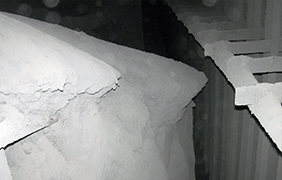Keys to Equipment Improvement
The objectives of equipment improvements are to optimize corona power, reduce re-entrainment, and optimize gas velocity distribution inside the precipitator. Some important topics to consider when planning equipment improvements include:
- Precipitator Size “ When sizing the precipitator, it is important to provide a cross-section that will maintain an acceptable gas velocity. It is also important to provide for enough total discharge wire length and collecting plate area, so that the desired specific corona current and electrical field can be applied.
- Gas Velocity Distribution “ Improving gas velocity distribution in the precipitator reduces particle re-entrainment and boosts precipitator efficiency. Typically, a uniform gas velocity is desired, but there are site-specific exceptions. Gas velocity distribution can be modified by using flow control devices and baffles. Refer to the special section on gas velocity distribution.
- Corona Power “ The separation of dust particles from the gas flow in an electrostatic precipitator depends on the applied corona power. Corona power is the product of corona current and voltage. Current is needed to charge the particles. Voltage is needed to support an electrical field, which in turn transports the particles to the collecting plates. For additional information, refer to Corona Power.
- Sectionalization “ The precipitator is divided into electrical sections that are cross-wise and parallel to the gas flow to accommodate spatial differences in gas and dust conditions. Optimization of corona power involves adjusting the corona power (secondary voltage and current) in each electrical section for optimum conditions.
- Particle ReEntrainment “ Minimizing reentrainment of dust particles is important to improvement of precipitator efficiency. Most precipitator equipment affects the reentrainment level. For a detailed discussion, visit the special section on re-entrainment.
- Additional Equipment “ Performance improvement options include the installation of a second precipitator in series with the existing precipitator; using fabric filters downstream of the precipitator; and adding a second particle collector in parallel with the existing collector. Other possibilities include sonic or electrostatic particle agglomerators upstream of the precipitator; a mechanical upstream collector; or an electrostatically-enhanced or mechanical collector, or a filter downstream of the precipitator.
- Review the General Equipment Requirements “ Reviewing the Neundorfer Knowledge Base sections on equipment will provide additional insight into performance improvements.
Helpful Resources:
KnowledgeBase: Optimizing Corona Power
KnowledgeBase: Reducing ReEntrainment
KnowledgeBase: Improve Flow Distribution
KnowledgeBase: Optimizing Precipitator Power Circuits
Our Capabilities: Analytical & Laboratory Services


